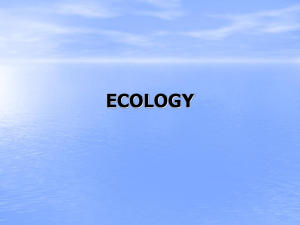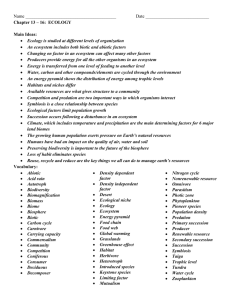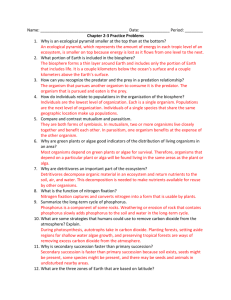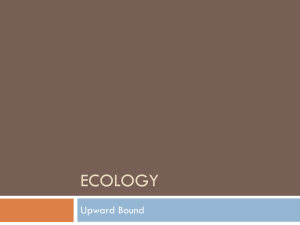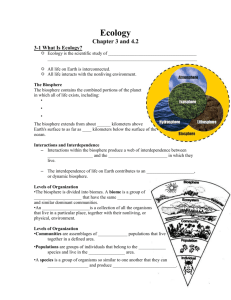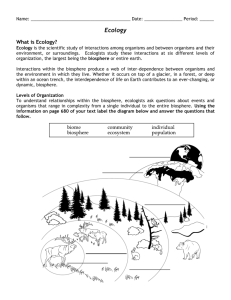Microsoft Word - 05.18.10
advertisement
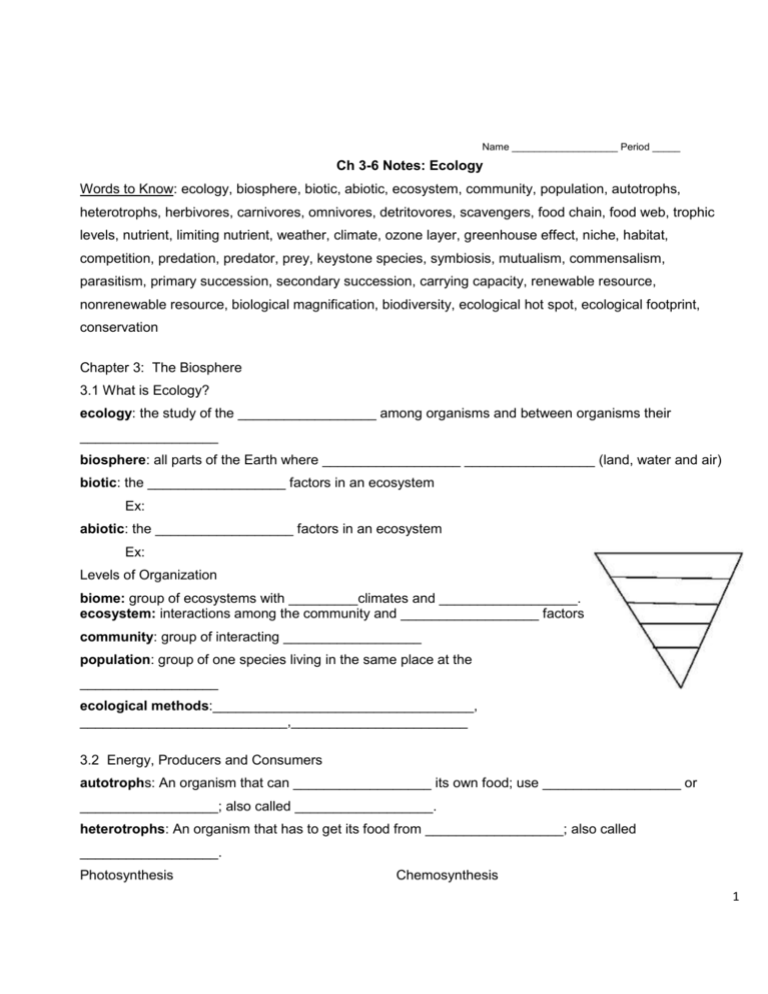
Name ___________________ Period _____ Ch 3-6 Notes: Ecology Words to Know: ecology, biosphere, biotic, abiotic, ecosystem, community, population, autotrophs, heterotrophs, herbivores, carnivores, omnivores, detritovores, scavengers, food chain, food web, trophic levels, nutrient, limiting nutrient, weather, climate, ozone layer, greenhouse effect, niche, habitat, competition, predation, predator, prey, keystone species, symbiosis, mutualism, commensalism, parasitism, primary succession, secondary succession, carrying capacity, renewable resource, nonrenewable resource, biological magnification, biodiversity, ecological hot spot, ecological footprint, conservation Chapter 3: The Biosphere 3.1 What is Ecology? ecology: the study of the __________________ among organisms and between organisms their __________________ biosphere: all parts of the Earth where __________________ _________________ (land, water and air) biotic: the __________________ factors in an ecosystem Ex: abiotic: the __________________ factors in an ecosystem Ex: Levels of Organization biome: group of ecosystems with _________climates and __________________. ecosystem: interactions among the community and __________________ factors community: group of interacting __________________ population: group of one species living in the same place at the __________________ ecological methods:__________________________________, ___________________________,_______________________ 3.2 Energy, Producers and Consumers autotrophs: An organism that can __________________ its own food; use __________________ or __________________; also called __________________. heterotrophs: An organism that has to get its food from __________________; also called __________________. Photosynthesis Chemosynthesis 1 Types of Heterotrophs herbivores: eat only __________________ examples: carnivores: eat only __________________ examples: omnivores: eat both ____________________________________examples: detritovores: break down __________________material; __________________ decomposers: break down ________________________material (meaning material that was once living) examples: ___________________________________ scavengers: eat ____________________________________ 3.3 Energy Flow in Ecosystems food chain: steps in which organisms ____________________ energy. food web: shows all the ___________________relationships in the ecosystem. Much more complex than food chain. trophic levels: Each step in a __________________. • As you move up trophic levels, __________________ of the energy is __________________. Pyramids Energy Pyramid __________________ Biomass: the total amount of ______________________________ in within each trophic level. 2 3.4 Cycles of Matter nutrient: __________________ an organism needs to sustain life. Carbon, Nitrogen & Phosphorous limiting nutrient: the nutrient whose supply __________________ productivity of producers ) Carbon ) Nitrogen ) Phosphorous 3 Nitrogen Cycle Phosphorous Cycle 4 Chapter 4 Ecosystems and Communities 4.1 Climate weather: the ______________ condition of the Earth at a particular _________ and _________ climate: the average, ______________conditions of ______________ and ______________ Effect of Latitude on Climate • The tilt of the Earth creates climate zones based on latitude: Heat Transport in the Biosphere • Unequal heating of the Earth drives _________ and ______________. • Air and water near the equator _________ and _________. ozone layer: Layer of the Earth’s atmosphere (_________km above Earth) containing _________ (O3) • Absorbs 93-99% of _________ The Greenhouse Effect: Natural situation where _________ trap the sun’s heat energy in the _________. • Maintains our _________. (Earth would be _________cooler without it.) 4.2 Niches and Community Interactions tolerance: the ability to __________________ and ________________________ under a range of environmental circumstances habitat: the general place where an organism lives, must be within tolerance. niche: __________________ an organism does to __________________. • All __________________ and __________________conditions. • What it eats, where it lives (__________________), how it avoids predators, etc. competition: Occurs when two organisms want the same resource at the same time. Competitive Exclusion Principle: No two species can occupy the same niche at the same time. predation: An interaction where one organism __________________ and __________________ on another organism. predator: __________________ prey: __________________ keystone species: A species that exerts strong control on the structure of a __________________ so that changes to its population causes __________________ changes Ex: sea otters symbiosis: Any relationship in which two species ____________________________________together. mutualism: __________________ species __________________ Ex: bees and flowers 5 commensalism: one species __________________ while the other is not __________________ Ex: barnacles on a whale parasitism: one species __________________, while the other is __________________ Ex: tapeworms-YUK! 4.3 Succession Ecological Succession primary succession: occurs where there is _________ Ex: after a _________ erupts secondary succession: occurs where there is _________ Ex: after a ______________ Chapter 5 5.1 How Populations Grow Describing populations Geographic range:___________________________________________________ Population density: the ______________of individuals per unit area Growth rate Age structure: the number of males and females of each age Humans in the Biosphere carrying capacity: The ______________ number of individuals of a particular species that a particular environment can ______________. renewable resource: can be ______________ by a healthy ecosystem Ex: trees, wind nonrenewable resource: ______________ be replenished by natural processes in a ______________ amount of time ) Ex: fossil fuels biological magnification: ______________ concentration of a harmful substance in organisms at higher ______________ levels in a food chain biodiversity: All of the organisms in the ______________ conservation: “wise use”; studying the loss of biodiversity & ways it can be ______________ ecological hot spot: a place where significant numbers of species and habitats are in ______________ danger of extinction ecological footprint: The total area of functioning land and water ecosystems needed to ______________ resources and ______________ the wastes of an individual or population. ) - Used to calculate the biosphere’s carrying capacity for ______________. 6
